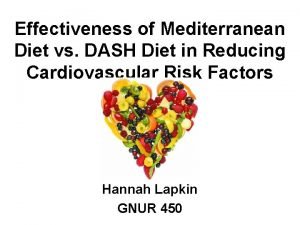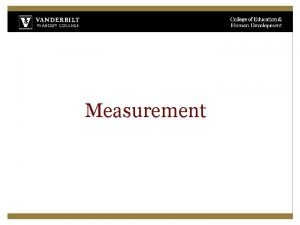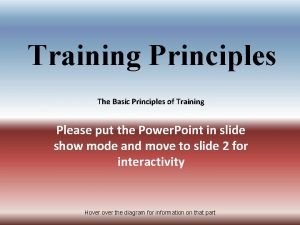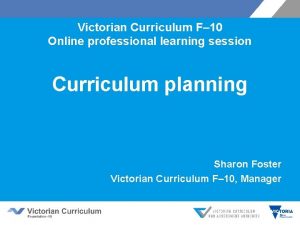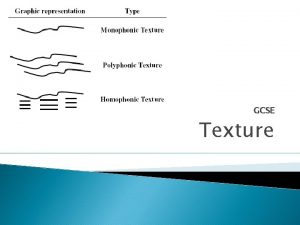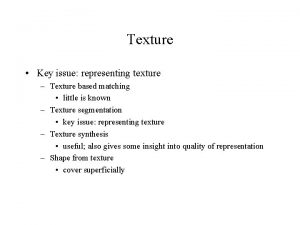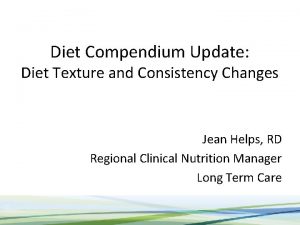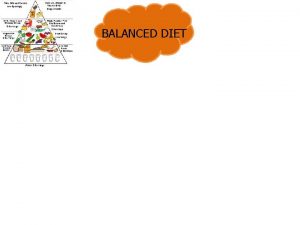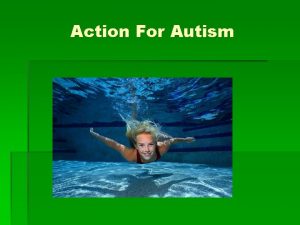Diet Texture Progression for Individuals with Autism When

















































































- Slides: 81

Diet Texture Progression for Individuals with Autism When Just Take a Bite Doesn’t Work Presentors Debra Beckman, MS, CCC-SLP Michele Cole Clark, MEd, CCC-SLP

Disclosure Statement • Michele Cole Clark has no financial disclosures to make • Michele is employed by the Marcus Autism Center, Pediatric Feeding Program, Atlanta, Ga. , which hosts the Beckman & Associates Beckman Oral Motor 2 -day certification course annually Beckman & Clark, ASHA, 2015

Disclosure Statement • Debra Beckman is employed by Beckman and Associates, Inc and receives compensation for presenting conferences regarding Beckman Oral Motor Assessment and Intervention • Debra Beckman receives royalties for 3 products she developed and patented, which are distributed by Ark Therapeutic Services • Tri-Chew Teether • E-Z Spoon • Beckman Professional Oral Probe Beckman & Clark, ASHA, 2015

Concerns are Multifactorial • • • Medical Behavioral Sensory Motor Social Beckman & Clark, ASHA, 2015

Problems Begin Early • Niehus & Lord (2006) • More ear infections • Use significantly more antibiotics. • More chronic gastrointestinal problems. • Barnevik Olsson et al (2013) • Regulatory problems (RP) were much more common in children from birth to age 2 who later received a diagnosis of ASD • Keen (2008) • Presence of severe or atypical feeding problems and FTT in infancy should alert professionals to possible underlying ASD Beckman & Clark, ASHA, 2015

Problems with Eating Occur Often • Sharp et al (2013) • Results indicated children with ASD experienced significantly more feeding problems versus peers • Marí-Bauset et al (2014) • There is empirical evidence and an overall scientific consensus supporting an association between food selectivity and autism spectrum disorders. • Hubbard et al (2014) • Children with ASD were significantly more likely to refuse foods based on texture/consistency (77. 4% vs 36. 2%), taste/smell (49. 1% vs 5. 2%), mixtures (45. 3% vs 25. 9%), brand (15. 1% vs 1. 7%), and shape (11. 3% vs 1. 7%). Beckman & Clark, ASHA, 2015

Poor Oral Intake Impacts Nutrition • Lower intake of calcium and protein (Sharp et al, 2013) • Increases in the degree of problematic feeding behaviors predicted decrements in nutritional adequacy (Johnson et al, 2014) • Body mass indices were below the 5 th percentile in 20 % of ASD versus 8. 85 % of TD children • Inadequacy of intake suggests that routine monitoring of children with ASD should include assessment of dietary habits, as well as anthropometric measurements (Marí-Bauset et al, 2015) Beckman & Clark, ASHA, 2015

Poor Oral Intake Impacts Nutrition • Higher average intake of magnesium • Lower average intake of protein, calcium, vitamin B 12, and vitamin D • Selective eaters were significantly more likely than typical controls to be at risk for at least one serious nutrient deficiency (Zimmer et al, 2012) • Routine screening for food refusal among children with ASD is warranted to prevent dietary inadequacies that may be associated with selective eating habits (Hubbard et al, 2014) Beckman & Clark, ASHA, 2015

Poor Oral Intake Impacts Nutrition • Lane et al (2014) • Severe autism-specific disruptive behaviors at mealtimes were most at risk for suboptimal intake of select nutrients such as biotin, vitamin K, iodine, linolenic omega-3 fatty acids, and choline, which play a role in metabolism and bone and brain health. Beckman & Clark, ASHA, 2015

Medical • Gastrointestinal Issues • Motility • Structure 59 percent of autistic children who were undergoing endoscopy for GI symptoms had carbohydrate digestive abnormalities, compared with only 11 percent in unaffected children undergoing endoscopy for GI symptoms. (Kushak et. al. , 2005) Beckman & Clark, ASHA, 2015

GI Concerns • Children with ASD experience significantly more general GI symptoms than comparison groups, with higher rates of diarrhea, constipation and abdominal pain (Mc. Elhanon et al, 2014) • Feeding difficulties may be caused by exacerbated symptoms of Eosinophilic Esophagitis (EE), a chronic inflammatory disorder manifesting itself predominantly in reflux-type symptoms that do not respond to standard antireflux pharmacotherapy (Jarocka-Cyrta, et al 2011) Beckman & Clark, ASHA, 2015

GI Concerns • Review by Vissoker, et al (2015) suggests a strong relationship and significant correlations between eating problems and gastrointestinal dysfunction. • Schreck, et al (2004) found that children with autism have significantly more feeding problems and eat a significantly narrower range of foods than children without autism. Beckman & Clark, ASHA, 2015

GI Concerns • Nadon, et al (2011) found that children with ASD had a mean of 13. 3 eating problems, with lack of food variety predominating. Siblings had 5. 0 problems. • Important to screen for mealtime problems • • GERD was the most prevalent condition found and was the factor most often associated with food refusal. Neurological conditions and anatomical anomalies were highly associated with skill deficits, such as oral motor delays and dysphagia (Field et al, 2003) Beckman & Clark, ASHA, 2015

GI Concerns • Meral & Fidan (2015) found feeding problems, mealtime problems and feeding strategies, play a significant and predictive role in health related quality of life for individuals with ASD • Eliminating feeding and mealtime problems and ameliorating parental feeding strategies/practices may promote the health related quality of life of children with ASD. Beckman & Clark, ASHA, 2015

GI Concerns • Problems could be • Functional – related to behaviors such as suboptimal eating and toileting habits, such as extreme food selectivity (often a preference for starches and snack foods and an aversion towards fruits and vegetables) or ineffective toileting routines. • Organic - related to biological factors, such as altered population of intestinal microbes, altered patterns of intestinal contractions, or increased risks of gluten sensitivity, lactose intolerance, food allergies, or gastroesophageal reflux disease Beckman & Clark, ASHA, 2015

Medical • Research (Mahikoa, 2006) is needed with a focus on • medical issues, including GI disorders, exacerbate autistic behaviors • recognition and treatment of underlying medical conditions will improve functional outcomes • raising awareness of underlying medical issues among medical providers will improve quality of life Beckman & Clark, ASHA, 2015

Behavioral • Unrecognized gastrointestinal disorders may contribute to behavioral problems, but are often overlooked since the clinical symptoms are nonspecific. (Jarocka-Cyrta, et al 2011) • Unusual sleeping or eating habits and oppositional behavior were significantly associated with GI problems. (Maenner et al, 2012) • Strong associations (Johnson et al, 2014) between parent reported feeding habits and • Repetitive and ritualistic behaviors • Sensory features • Externalizing and internalizing behavior Beckman & Clark, ASHA, 2015

Behavioral/ Social • Dewrang & Sandberg (2010) found that parents in many cases were well aware of anomalies in their children's behavior at an early age. • Areas of most concern were • Food/feeding • Sleep • Contact • Social activity Beckman & Clark, ASHA, 2015

Behavioral/ Social • Provost, et al (2010) • More children with ASD were picky eaters, mouthed nonfood items, resisted new foods, limited foods based on textures, had problems with gagging, had difficulty eating at regular restaurants or at school, resisted sitting at the table, and threw or dumped food. • Knowledge of these early differences can help pediatric therapists to assess feeding issues and plan interventions. Beckman & Clark, ASHA, 2015

Social • Schreck & Williams (2006) found that children with ASD preferred fewer types of food items within groups than their families; however, family food preferences appeared to influence food selection more than the diagnostic characteristics of autism. Beckman & Clark, ASHA, 2015

Oral Motor Concerns • Brisson et al (2012) • Autism/ASD group had an early oral motor anticipation deficit (did not open their mouths as infants when the spoon was presented) • Manno et al (2005) • Oral-motor interventions have been shown to be effective in improving the oral function • Oral-motor problems may be under identified Beckman & Clark, ASHA, 2015

Minimal competence for oral motor skills before beginning with introduction of new foods 50/50 chance of controlling the bolus 10 vertical jaw movements in 10 seconds 67% midblade tongue elevation 40% posterior cheek activation (Beckman, 2013) Beckman & Clark, ASHA, 2015

Motor Control for Smooth Muscle • Smooth muscle does not strengthen • Changes with stretch memory • If incoming material is perceived as stretching too much, the brain stem activates the Vagal Nerve Response (immediate gag/reflux) Beckman & Clark, ASHA, 2015

Vagal Nerve Response • Brain Stem response • Not under cognitive control • Abnormalities in autonomic nervous reflexes might account for the frequent occurrence of gastro-esophageal reflux and may be involved in the production of disordered gastrointestinal motility (Smart & Atkinson, 1987) Beckman & Clark, ASHA, 2015

Peristaltic Practice (Beckman) • Must make incrementally small changes in stretch • Sensory motor response is best for this • Increase quantity before variety • Increase variety before texture • Goal: 20 different foods that can be consumed at 4 ounces in 20 minutes at an age appropriate texture: • 5 Protein • 5 Starches • 5 Fruits • 5 Vegetables Beckman & Clark, ASHA, 2015

Beckman Sensory Motor Approach © Beckman, 2013 Beckman & Clark, ASHA, 2015

Assessment with Beckman Oral Motor Protocol Video with 3. 8 year old with diagnosis of Autism Sessions began in December of 2013 One session a week for 30 minutes Parent participated in every session Video session # 40 Beckman & Clark, ASHA, 2015

Profile of the Child with ASD: Marcus Autism Center Pediatric Feeding Program • • Highly rigid in general daily routine including mealtime Strong aversions to texture & appearance variations Oral motor baseline skill Mild to severe skill deficits of jaw strength, durational jaw strength, and variety of lingual movement i. e. , lingual lateralization Sensory hypervigilance Behaviors that halt progress on multiple tasks • secondary to rigidity with food presentations • secondary to sensory sensitivities/intolerance Beckman & Clark, ASHA, 2015

Assessment • Beckman Oral Motor Evaluation • Non-nutritive motor skill • Oral Hypersensitivity Scale Beckman, 2004 • Sensory tolerance • Meal Observation • Nutritive skill • Developmental feeding skill • Parent Interview • Behaviors surrounding the meal/feeding, medical hx, • Collaboration with Behavioral psychology and Nutrition Beckman & Clark, ASHA, 2015 services


Oro-sensory function and oral motor function cannot develop independently of one another Morris & Klein, 2000 We cannot change the foods going into the mouth without touching the mouth D Beckman, 2013 Beckman & Clark, ASHA, 2015

The Problems Food Refusal Food Selectivity Hypervigilance is primary to the disruptive behaviors that grow out of initial experiences and alter treatment outcomes heavily impacting nutrition Beckman & Clark, ASHA, 2015

ASD: Generalization of Skills The (in)ability to adapt motor responses and/or movements used for one task to complete other (similar) novel tasks. • Issues of generalization vs Apraxia? • High repetition of tasks • Target specific foods and textures commensurate with functional skill Beckman & Clark, ASHA, 2015

ASD: Food Selectivity • Texture • Prefer processed dissolvables vs firm/fibrous chewables • Type • Categories of foods i. e. , no fruits/veggies, color, shape, brand, presentation, place • Difficulty generalizing skills from one food to another similar food & across categories leads to… Experience-based motor deficits Beckman & Clark, ASHA, 2015

Experience-based Deficits • Deficits that develop for children who avoid or have not had the opportunity to engage in consistent oral sensorimotor activities • Lack of experience secondary to a medical complication w/otherwise intact motor system • Tend to change more easily once the motor tasks have been introduced vs organic motor deficits and difficulty generalizing skills • ASD Beckman & Clark, ASHA, 2015

The Challenge • Balance the child’s nutrition in meal (Dietician) • Increase variety of foods in repertoire • Improve functional oral sensorimotor skill to increase texture by mouth While simultaneously: • Decreasing disruptive behaviors • Timely progress in treatment • Best practices ✔Evidence-based treatment approaches Therapist-lead vs Child-lead treatment Beckman & Clark, ASHA, 2015

Child-lead vs Therapist-lead A Comparison of the Sequential-Oral-Sensory Approach to an Applied Behavior Analytic Approach in the Treatment of Food Selectivity in Children with Autism Kathryn M. Peterson, Valerie M. Volkert, Cathleen C. Piazza, Ashley M. Niebauer, & Kayla D. Broksle, 2014 University of Nebraska Medical Center’s Munroe-Meyer Institute 37 Beckman & Clark, ASHA, 2015

Petersen et al, 2014 • Six boys, b/w 4 and 6 years of age; all diagnosed with an ASD • Weight for height WNL • All displayed chewing skills and were safe oral feeders 38

Therapist-lead Intervention Oral Motor Intervention Model • Establish baseline oral motor skill to identify the key motor targets • Address deficits of strength and range of movement of lips, cheeks, and jaw, and the variety of movement the of tongue • Based on Beckman criterion-referenced skill expectations • Goals specific to the functional nutritive & nonnutritive deficits /mealtime concerns 39 Beckman & Clark, ASHA, 2015

Therapist-lead Intervention Oral Motor Intervention Model • Incorporates principles of Behavioral Psychology i. e. , applied behavior analysis • Antecedent manipulation • Change what precedes behavior • Persistence • Remove escape from the task • Reasonable request or task demand • Fading the demand 40 Beckman & Clark, ASHA, 2015

To facilitate progression from session to session… Reasonable Request Data Treatment Session Motivation Beckman & Clark, ASHA, 2015

Reasonable Request • Provide consistent, persistent reasonable requests to complete a task or consume a food • Reasonable request means lowering the expectation of the task to a level that is achievable for the child • Persistence means not removing a task request or allowing escape from the task • Persisting in the face of escalating behaviors • Crying, eloping, negative vocalizations Head turns, batting at your hand, hitting • Gagging & emesis Beckman & Clark, ASHA, 2015

Reasonable Request: Meet the child where he is… Desensitize to… Beckman & Clark, ASHA, 2015

Meet the child where he is… Dissolvable solids Crisp/Crunchy/Chewy Chewable solids Beckman & Clark, ASHA, 2015

Meet the child where he is…. . Developmentally appropriate vs Age appropriate Beckman & Clark, ASHA, 2015

Texture Progression Texture • Puree • Wet-ground • Ground • Chopped • ¼” x ¼” (pea size) table texture (texture changes when child meets decision rule criteria to ↑) Bolus size • Empty (maroon spoon) • Tip dipped/rice • ½ level • Level • Rounded • Heaping • 1 pea size • 2 pea size (cont. to double size) Beckman & Clark, ASHA, 2015

Bolus Progression Rice size 1 pea size ½ level Level Rounded Heaping Beckman & Clark, ASHA, 2015

¼” pea size table texture ½” size table texture 2 pea size table texture Level pea size table texture Beckman & Clark, ASHA, 2015

Persistence with a Reasonable Task Demand • Not removing the demand once participation is requested • Persisting as long as it takes • Not allowing escape from the task demand by removing the spoon/tool/food (non-removal of the task) • The tool/spoon/gloved finger should remain at the lips until accepted (not going in the mouth) Beckman & Clark, ASHA, 2015

Persistence with a Reasonable Task Demand • Not removing the demand once participation is requested • Persisting as long as it takes • Not allowing escape from the request by removing the spoon/tool/food with increased behaviors. • The tool/spoon/gloved finger should remain at the lips until accepted • Recognition that a demand may be too great or unreasonable for the child • Decrease the demand to accomplish the task and work forward again – take your time, move slowly Beckman & Clark, ASHA, 2015


Progress in Treatment Data Beckman & Clark, ASHA, 2015

Definitions & Decision Rules Assessment of oral-motor skills should include task analysis of the movement typically observed in the wide range of normal skill developments Lori Overland CCC/SLP Operational Definitions and Decision Rules • Data is used to guide decisions regarding fading, shaping, or your target of intervention 53 Beckman & Clark, ASHA, 2015

Operational Definition Must be specific to assure the definition is so narrow in scope that others would observe only what you had in mind Allows 2 or more people to collect data for the same set of target behaviors Observable Measurable Beckman & Clark, ASHA, 2015

Data Collection: Oral Motor & Sensory Targets • Vertical Chew Rhythmical, resistive chew • Lateralization of the tongue from mid-line • Mid-blade elevation of the tongue • Reduced occurrences of gagging • Reduced occurrences of emesis Beckman & Clark, ASHA, 2015

Operational Definition: Motor Task Chewing A rhythmical (1 chew/second), resistive vertical movement of the jaw Vertical movement of the jaw Resistive (graded pressure) 1 chew/second 56 Beckman & Clark, ASHA, 2015

Operational Definition / Goal Motor task- Chewing: Pt will demonstrate lateralization of a pea size bolus to the molars for a rhythmical (1 chew/second), resistive chew 8 -10 times prior to the swallow at 80% of opportunities, 20% or less gags, and no emesis. Behavioral task- Decreased disruptive behaviors: Pt will accept the bite within 5 seconds of presentation and swallow the bite within 30 seconds with 20% or less gags and no emesis Beckman & Clark, ASHA, 2015

Decision Rule A set of specific measurable and observable criteria that guide specific decisions or identify readiness for progression i. e. , texture progression 58 Beckman & Clark, ASHA, 2015

Decision Rule Beckman: Minimal competence for oral motor skills before beginning with introduction of new foods 10 vertical jaw movements in 10 seconds 67% midblade tongue elevation 40% posterior cheek activation (Beckman, 2013) Beckman & Clark, ASHA, 2015

Decision rules tell you when to… • Begin puree by mouth • Increase texture from puree to dissolvable solids in practice • Increase texture from dissolvable solid to chewable solid in practice • Increase texture in the meal from puree to ground • Increase texture in the meal from ground to chewable (¼ “ x ¼”) table texture Beckman & Clark, ASHA, 2015

Data is used to guide decisions regarding fading demands, shaping behaviors, or your intervention targets Beckman & Clark, ASHA, 2015

Beckman & Clark, ASHA, 2015 62

Progress in Treatment Motivation Beckman & Clark, ASHA, 2015

Motivation Highly motivating activity • Singing favorite songs, • Favorite toy, • i. Pad, DVD • Tickles & giggles • Must be worth working for! Beckman & Clark, ASHA, 2015

Motivation The child’s “why” is the END of the task Counting aloud through tasks helps identify the “end“ of the task and ↓ anxiety • Video of N Beckman & Clark, ASHA, 2015

Progress in Treatment Session Beckman & Clark, ASHA, 2015

Structure of the Treatment Session • Establish a routine that the child can expect each and every session • Do not vary the routine! • Fear/anxiety/ASD need the routine to remain the same to feel less anxious • Give a 20 -30 second break b/w tasks & before beginning next task Beckman & Clark, ASHA, 2015

Structured Treatment Session • Room set-up: Same chair, tools, motivating activity, etc. • Use the same commands to signal the task – “take a bite, ” “time to chew, ” or “my turn/your turn” • Use labeled praise- “Good job chewing!, ” “Good job swallowing!, ” “Good job taking your bite!” Beckman & Clark, ASHA, 2015

Home Program • Frequency of practice trumps intensity of practice • Short practice sessions (no longer than 5 -10 minutes) • Practice 3 times per day (no more than 5 times/day) • Parent is coached in weekly sessions to accomplish the home program; • Parents/caregivers must be aware that behavior challenges will occur at home • Do not send home practice that is not return demonstrated in the session with you coaching the parent through persistence with a reasonable request Beckman & Clark, ASHA, 2015

Putting All the Pieces Together • Choose 4 of the more important foods to onboard based on Dietician’s assessment of nutrient needs • Baseline motor deficits • Identify the motor deficits for specific target work • Meal • Consider lowest texture to create ease of intake within the meal (usually puree) • Volume before variety • Easier to increase volume with an easy to swallow food, one that does not require motor coordination and durational strength • Reduce refusal • Antecedent manipulation/reduce escape from the task Beckman & Clark, ASHA, 2015

Remember… üNutrition is the reason we focus on feeding The child’s growth and development is at risk üAddress volume first & texture second üCost of treatment over time: Evidence-based treatment strategies Beckman & Clark, ASHA, 2015

Contact Information • Debra Beckman, MS, CCC-SLP Beckman & Associates, Inc. 620 N Wymore Rd, Suite 230 Maitland, FL 32751 info@beckmanoralmotor. com 407 -647 -4740 www. beckmanoralmotor. com • Michele Cole Clark, MEd, CCC-SLP Marcus Autism Center 1920 Briarcliff Rd. NE Atlanta Georgia 30329 michele. cole-clark@choa. org 404 -785 -9378 Beckman & Clark, ASHA, 2015

References • Barnevik Olsson, M, Carlsson, LH, Westerlund, J, Gillberg, C, and Fernell, E. (2013). Autism before diagnosis: crying, feeding and sleeping problems in the first two years of life, Acta Paediatrica, June, Vol. 102(6), p. 635 -639. • Beckman, DA, (1986, rev. 2013). Beckman Oral Motor Assessment and Intervention. Published by Beckman & Associates, Inc. , 620 N Wymore Rd, Suite 230, Maitland, FL 32750. • Brisson, J, Warreyn, P, Serres, J, Foussier, S, and Adrien-Louis, J. (2012). Motor anticipation failure in infants with autism: a retrospective analysis of feeding situations. Autism, Vol. 16(4), pp. 420 -429. Beckman & Clark, ASHA, 2015

References • Cermak, SA, Curtin, C, and Bandini, LG. (2010). Food selectivity and sensory sensitivity in children with autism spectrum disorders, Journal of the American Dietetic Association, 110, 259 - 264. • Dewrang, P, and Sandberg, AD. (2010). Parental retrospective assessment of development and behavior in Asperger Syndrome during the first 2 years of life, Research in Autism Spectrum Disorders, Vol. 4(3), p. 461 -473. • Field, D, Garland, M, and Williams, K. (2003). Correlates of specific childhood feeding problems, Journal of Paediatrics and Child Health, Vol. 39(4), pp. 299 -304. • Hubbard, KL, Anderson, SE, Curtin, C, Must, A, and Bandini, LG. (2014). A comparison of food refusal related to characteristics of food in children with autism spectrum disorder and typically developing children, Journal of the Academy of Nutrition and Dietetics, Vol. 114(12), pp. 1981 -1987. Beckman & Clark, ASHA, 2015

References • Jarocka-Cyrta, E, Wasilewska, J, and Kaczmarski, M. (2011). Brief Report: Eosinophilic esophagitis as a cause of feeding problems in autistic boy. The first reported case, Journal of Autism and Developmental Disorders, Vol. 41(3), pp. 372 -374. • Johnson, CR, Turner, K, Stewart, PA, Schmidt, B, Shui, A, Macklin, E, Reynolds, A, James, J, Johnson, SL, Manning Courtney, P, and Hyman, SL. (2014). Relationships between feeding problems, behavioral characteristics and nutritional quality in Children with ASD, Journal of Autism and Developmental Disorders, Vol. 44(9), p. 21752184. • Keen, DV. (2008). Childhood autism, feeding problems and failure to thrive in early infancy, European Child & Adolescent Psychiatry, Vol. 17(4), pp. 209 -216. Beckman & Clark, ASHA, 2015

References • Kushak, R, Winter, H, Farber, N and Buie, T. (2005). Gastrointestinal symptoms and intestinal disaccharidase activities in children with autism. Journal of Pediatric Gastroenterology and Nutrition, Vol. 41, No. 4, October. • Lane, AE, Geraghty, ME, Young, GS, and Rostorfer, JL. (2014). Problem eating behaviors in autism spectrum disorder are associated with suboptimal daily nutrient intake and taste/smell sensitivity, ICAN: Infant, Child, & Adolescent Nutrition, Vol. 6(3), pp. 172 -180. • Maenner MJ, Arneson CL, Levy SE, Kirby RS, Nicholas JS, and Durkin MS. (2012). Brief report: Association between behavioral features and gastrointestinal problems among children with autism spectrum disorder. Journal of Autism Developmental Disorders, Jul; 42(7): 1520 -5. • Mahikoa, K. (2006). Gastrointestinal illness in autism: An interview with Tim Buie, M. D. Autism Advocate, FIFTH EDITION. http: //www. autismsociety. org/wp-content/uploads/2014/04/Gastrointestinal-Illness-in. Autism. pdf Beckman & Clark, ASHA, 2015

References • Manno, CJ, Fox, C, Eicher, PS, and Kerwin, ME. (2005). Early oralmotor interventions for pediatric feeding problems: What, When and How, Journal of Early and Intensive Behavior Intervention, Vol. 2(3), p. 145 -159. • Marí-Bauset, S, Llopis-González, A, Zazpe-García, I, Marí-Sanchis, A, and Morales-Suárez-Varela, M. (2015). Nutritional status of children with autism spectrum disorders (ASDs): A case–control study, Journal of Autism and Developmental Disorders, Vol. 45(1), pp. 203 -212. • Marí-Bauset, S, Zazpe, I, Mari-Sanchis, A, Llopis-González, A, and Morales-Suárez-Varela, M. (2014). Food selectivity in autism spectrum disorders, Journal of Child Neurology, 2014, Vol. 29(11), pp. 1554 -1561. • Mc. Elhanon BO, Mc. Cracken C, Karpen S, and Sharp WG. (2014). Gastrointestinal symptoms in autism spectrum disorder: a metaanalysis, Pediatrics. May; 133 (5): 872 -83. 214. Beckman & Clark, ASHA, 2015

References • Meral, BF, and Fidan, A. (2015). Measuring the impact of feeding covariates on health-related quality of life in children with autism spectrum disorder, Research in Autism Spectrum Disorders, February, Vol. 10, pp. 124 -130. • Morris, SE and Kline, MD. (2001). Pre-feeding skills: A comprehensive resource mealtime development (2 nd Edition). San Antonio, TX: The Psychological Corporation. • Nadon, G, Feldman, DE, Dunn, W, and Gisel, E. (2011). Mealtime problems in children with autism spectrum disorder and their typically developing siblings: a comparison study, Autism: The International Journal of Research and Practice 2011, Vol. 15(1), pp. 98113. • Niehus R, and Lord C. (2006). Early medical history of children with autism spectrum disorders. Journal of Developmental Behavioral Pediatrics. Apr; 27(2 Suppl): S 120 -7. Beckman & Clark, ASHA, 2015

References • Overland, L CCC/SLP, A sensory-motor approach to feeding; Perspectives on swallowing and swallowing disorders, ASHA http: //journals. asha. org/perspectives • Peterson, K. M. , Volkert, V. M. , Piazza, C. C. , Niebauer, A. M. , and Broksle, K. D. (2014, May). A comparison of the sequential-oralsensory approach to an applied behavior analytic approach in the treatment of food selectivity in children with autism. Symposium conducted at the meeting of Association of Behavior Analysis International, Chicago, IL. • Provost, B, Crowe, TK, Osbourn, PL, Mc. Clain, C, and Skipper, BJ. (2010). Mealtime behaviors of preschool children: Comparison of children with Autism Spectrum Disorder and children with typical development, Physical & Occupational Therapy in Pediatrics, Vol. 30(3), p. 220 -233. Beckman & Clark, ASHA, 2015

References • Schreck, KA, and Williams, K. (2006). Food preferences and factors influencing food selectivity for children with autism spectrum disorders, Research in Developmental Disabilities: A Multidisciplinary Journal, Vol. 27(4), p. 353 -363. • Schreck, KA, Williams, K, and Smith, AF. (2004). A comparison of eating behaviors between children with and without autism, Journal of Autism and Developmental Disorders, 2004, Vol. 34(4), p. 433 -438. • Sharp, W, Berry, R, Mc. Cracken, C, Nuhu, N, Marvel, E, Saulnier, C, Klin, A, Jones, W, and Jaquess, D. (2013). Feeding problems and nutrient intake in children with autism spectrum disorders: A metaanalysis and comprehensive review of the literature. Journal of Autism and Developmental Disorders, 2013, Vol. 43(9), pp. 2159 -2173. • Sharp, WG, Jaquess, DL, Morton, JF, and Herzinger, CV. (2010). Pediatric feeding disorders: A quantitative synthesis of treatment outcomes. Clinical Child and Family Psychology Review, 13, 348 -365. Beckman & Clark, ASHA, 2015

References • Smart, H. L. , and Atkinson, M. (1987). Abnormal Vagal Function in Irritable Bowel Syndrome, The Lancet, Volume 330, No. 8557, August, p 475 -478. • Vissoker, RE, Latzer, Y, and Gal, E. (2015). Eating and feeding problems and gastrointestinal dysfunction in autism spectrum disorders, Research in Autism Spectrum Disorders, April 2015, Vol. 12, pp. 10 -21. • Zimmer, MH, Hart, LC, Manning - Courtney, P, Murray, DS, Bing, NM, and Summer, S. (2012). Food variety as a predictor of nutritional status among children with autism, Journal of Autism and Developmental Disorders, April, 2012, Vol. 42(4), p. 549 -556. Beckman & Clark, ASHA, 2015
 Implied or simulated texture has tactile feel
Implied or simulated texture has tactile feel Dash diet vs mediterranean diet
Dash diet vs mediterranean diet Shivaismen
Shivaismen Centrum för kunskap och säkerhet
Centrum för kunskap och säkerhet Personalliggare bygg undantag
Personalliggare bygg undantag Verktyg för automatisering av utbetalningar
Verktyg för automatisering av utbetalningar Aktiv exspektans
Aktiv exspektans Jag har gått inunder stjärnor text
Jag har gått inunder stjärnor text Inköpsprocessen steg för steg
Inköpsprocessen steg för steg Strategi för svensk viltförvaltning
Strategi för svensk viltförvaltning Varians
Varians Datorkunskap för nybörjare
Datorkunskap för nybörjare Tack för att ni har lyssnat
Tack för att ni har lyssnat Treserva lathund
Treserva lathund Ekologiskt fotavtryck
Ekologiskt fotavtryck Läkarutlåtande för livränta
Läkarutlåtande för livränta Påbyggnader för flakfordon
Påbyggnader för flakfordon Tack för att ni lyssnade
Tack för att ni lyssnade Egg för emanuel
Egg för emanuel Atmosfr
Atmosfr Rutin för avvikelsehantering
Rutin för avvikelsehantering Vad är vanlig celldelning
Vad är vanlig celldelning Verifikationsplan
Verifikationsplan Tidbok för yrkesförare
Tidbok för yrkesförare Myndigheten för delaktighet
Myndigheten för delaktighet Presentera för publik crossboss
Presentera för publik crossboss Rbk-mätning
Rbk-mätning Fspos
Fspos Kung dog 1611
Kung dog 1611 Tack för att ni har lyssnat
Tack för att ni har lyssnat Tobinskatten för och nackdelar
Tobinskatten för och nackdelar Stig kerman
Stig kerman Vad är referatmarkeringar
Vad är referatmarkeringar Epiteltyper
Epiteltyper Shingelfrisyren
Shingelfrisyren Karttecken kraftledning
Karttecken kraftledning Lufttryck formel
Lufttryck formel Tallinjen
Tallinjen Elektronik för barn
Elektronik för barn Borra hål för knoppar
Borra hål för knoppar Anatomi organ reproduksi
Anatomi organ reproduksi Smärtskolan kunskap för livet
Smärtskolan kunskap för livet Bris för vuxna
Bris för vuxna Mat för unga idrottare
Mat för unga idrottare Typiska drag för en novell
Typiska drag för en novell Frgar
Frgar Teckenspråk minoritetsspråk argument
Teckenspråk minoritetsspråk argument Ellika andolf
Ellika andolf Delegerande ledarskap
Delegerande ledarskap Toppslätskivling effekt
Toppslätskivling effekt Steg för steg rita
Steg för steg rita Hur skriver man en debattartikel
Hur skriver man en debattartikel Redogör för vad psykologi är
Redogör för vad psykologi är Gumman cirkel sång
Gumman cirkel sång Bästa kameran för astrofoto
Bästa kameran för astrofoto En lathund för arbete med kontinuitetshantering
En lathund för arbete med kontinuitetshantering Ledarskapsteorier
Ledarskapsteorier Offentlig förvaltning
Offentlig förvaltning Haiku dikt exempel
Haiku dikt exempel Plagg i gamla rom
Plagg i gamla rom Orubbliga rättigheter
Orubbliga rättigheter Vad är densitet
Vad är densitet Ministerstyre för och nackdelar
Ministerstyre för och nackdelar Bamse för de yngsta
Bamse för de yngsta Tack för att ni lyssnade bild
Tack för att ni lyssnade bild Tillitsbaserad ledning
Tillitsbaserad ledning Plats för toran ark
Plats för toran ark Sju för caesar
Sju för caesar Nyckelkompetenser för livslångt lärande
Nyckelkompetenser för livslångt lärande Mästar lärling modellen
Mästar lärling modellen Ledningssystem för verksamhetsinformation
Ledningssystem för verksamhetsinformation Borstål, egenskaper
Borstål, egenskaper Difference between progress and progression
Difference between progress and progression Victorian curriculum technology
Victorian curriculum technology Bts fed option dbc
Bts fed option dbc Repeating decimal infinite geometric series
Repeating decimal infinite geometric series Sum of geometric progression
Sum of geometric progression Principles of training progression
Principles of training progression Singing progression
Singing progression Dating god's way
Dating god's way Vic curriculum progression points
Vic curriculum progression points Progression spiralaire
Progression spiralaire

